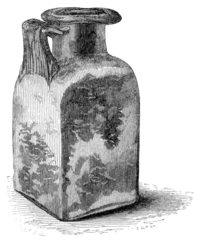ment[1], but resembling such as have been found in Pompeii amongst objects of domestic luxury used by the wealthier Romans. The dimensions of this vase are as follows: breadth of side, 7 in.; height to neck, 11 in.; whole height, 1 ft. 234 in.; breadth of neck, 812 in.; breadth of top, 512 in. It is probable that the wine in which the ashes were usually soaked after the extinction of the pyre, was poured from this vase, and that it was then appropriated as a receptacle for the burnt bones.
With this vase, now deposited in the British Musemn, were found four small and rather shallow pateræ of the red glazed Roman ware: they were disposed round the glass præfericulum, and were all stamped at the bottom with the potters' names. On two of them may be read indistinctly ENII AM, and . . . ENITA • M., which may be explained as GENITALIS MANU, denoting the fabric of the potter Genitalis, whose ware is not of uncommon occurrence in the excavations made in the city of London. The other two bear the stamps BVI.VRBI, or BVITVRBI, the fabric of Buiturbus, perhaps a barbaric mode of writing Viterbus; at all events a Celto-Roman name, finding its analogies in Buolminus, Boadicea, and Boduocus.
These wares were not improbably the produce of the Celto-Roman furnaces of Britannia Prima. Dimensions of the pateræ of Roman ware: diameter at top, 4 in.; ditto at base, 2 in.; height, 2 in.
The use of glass had probably penetrated at an early period into Britain, although one of the remotest corners of the Roman world, for amongst the tumuli opened on the borders of Cambridgeshire and Essex, called the Bartlow Hills, in one instance was found a class vessel with a second brass Roman coin of the age of Hadrian[2]. That glass was not exceedingly

